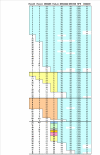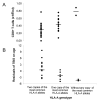A study of 82 extended HLA haplotypes in HFE-C282Y homozygous hemochromatosis subjects: relationship to the genetic control of CD8+ T-lymphocyte numbers and severity of iron overload
- PMID: 16509978
- PMCID: PMC1413516
- DOI: 10.1186/1471-2350-7-16
A study of 82 extended HLA haplotypes in HFE-C282Y homozygous hemochromatosis subjects: relationship to the genetic control of CD8+ T-lymphocyte numbers and severity of iron overload
Abstract
Background: It has been recently demonstrated that CD8+ T-lymphocyte numbers are genetically transmitted in association with the MHC class I region. The present study was designed with the objective of narrowing the region associated with the setting of CD8+ T-lymphocyte numbers in a population of C282Y homozygous hemochromatosis subjects, in whom a high prevalence of abnormally low CD8+ T-lymphocyte counts has been described.
Methods: The study includes 43 C282Y homozygous subjects fully characterized both phenotypically and genotypically. Clinical characterization includes measurements of iron parameters at diagnosis (transferrin saturation and serum ferritin), total body iron stores and T-cell immunophenotyping determined by flow cytometry. Genetic characterization includes HLA class I alleles (A, B and C) and four additional microsatellite markers (D6S265, D6S2222, D6S105 and D6S2239) spanning 5 Megabases in the 6p21.3 region.
Results: Eighty-two extended C282Y carrying haplotypes were defined. Single-locus analysis revealed that the HLA-A region was associated with CD8+ T-cell numbers. Multivariate analysis showed that the combinations of the most common HLA-A alleles (HLA-A*03, -A*02 and -A*01) were associated with significantly lower numbers of CD8+ T-lymphocytes (0.30 +/- 0.14 x 106/ml), in comparison with subjects carrying only one copy of those alleles (0.46 +/- 0.19 x 106/ml) and subjects without any copy of those alleles (0.79 +/- 0.15 x 106/ml;p = 0.0001). No differences were observed in CD8+ T-cell counts among control subjects carrying the same combinations of HLA-A alleles (0.47 +/- 0.14; 0.45 +/- 0.21 and 0.41 +/- 0.17 x 106/ml, respectively), therefore not supporting a direct effect of HLA specificity but rather an indirect association with a locus close to HLA-A. Multivariate analysis showed that the combination of the most common HLA-A alleles also have an impact on the clinical expression of HH in terms of iron stores, in males(p = 0.0009).
Conclusion: The present study provides evidence supporting an inextricable link between extended HLA haplotypes, CD8+ T-lymphocyte numbers and severity of iron overload in hereditary hemochromatosis(HH). It gives additional information to better define a candidate region involved in the regulation of CD8+ T-lymphocyte numbers. A new evolutionary hypothesis concerning the inheritance of the phenotype of low CD8+ T-lymphocyte numbers associated with particular ancestral HLA haplotypes carrying the C282Y mutation and its implication on the clinical heterogeneity of HH is discussed.
Figures




Similar articles
-
Low serum transferrin levels in HFE C282Y homozygous subjects are associated with low CD8(+) T lymphocyte numbers.Blood Cells Mol Dis. 2005 Nov-Dec;35(3):319-25. doi: 10.1016/j.bcmd.2005.08.001. Epub 2005 Sep 1. Blood Cells Mol Dis. 2005. PMID: 16140024
-
Effects of highly conserved major histocompatibility complex (MHC) extended haplotypes on iron and low CD8+ T lymphocyte phenotypes in HFE C282Y homozygous hemochromatosis patients from three geographically distant areas.PLoS One. 2013 Nov 25;8(11):e79990. doi: 10.1371/journal.pone.0079990. eCollection 2013. PLoS One. 2013. PMID: 24282517 Free PMC article.
-
HLA haplotype A*03-B*07 in hemochromatosis probands with HFE C282Y homozygosity: frequency disparity in men and women and lack of association with severity of iron overload.Blood Cells Mol Dis. 2005 Jan-Feb;34(1):38-47. doi: 10.1016/j.bcmd.2004.08.022. Blood Cells Mol Dis. 2005. PMID: 15607698
-
HFE, the MHC and hemochromatosis: paradigm for an extended function for MHC class I.Tissue Antigens. 2003 Apr;61(4):263-75. doi: 10.1034/j.1399-0039.2003.00065.x. Tissue Antigens. 2003. PMID: 12753664 Review.
-
Hereditary hemochromatosis: impact of molecular and iron-based testing on the diagnosis, treatment, and prevention of a common, chronic disease.Arch Pathol Lab Med. 1999 Nov;123(11):1053-9. doi: 10.5858/1999-123-1053-HH. Arch Pathol Lab Med. 1999. PMID: 10539907 Review.
Cited by
-
Carriers of the Complex Allele HFE c.[187C>G;340+4T>C] Have Increased Risk of Iron Overload in São Miguel Island Population (Azores, Portugal).PLoS One. 2015 Oct 26;10(10):e0140228. doi: 10.1371/journal.pone.0140228. eCollection 2015. PLoS One. 2015. PMID: 26501199 Free PMC article.
-
Low numbers of CD8+ T lymphocytes in hereditary haemochromatosis are explained by a decrease of the most mature CD8+ effector memory T cells.Clin Exp Immunol. 2010 Mar;159(3):363-71. doi: 10.1111/j.1365-2249.2009.04066.x. Epub 2009 Dec 14. Clin Exp Immunol. 2010. PMID: 20015273 Free PMC article.
-
HFE Related Hemochromatosis: Uncovering the Inextricable Link between Iron Homeostasis and the Immunological System.Pharmaceuticals (Basel). 2019 Aug 22;12(3):122. doi: 10.3390/ph12030122. Pharmaceuticals (Basel). 2019. PMID: 31443397 Free PMC article.
-
CD4:CD8 lymphocyte ratio as a quantitative measure of immunologic health in HIV-1 infection: findings from an African cohort with prospective data.Front Microbiol. 2015 Jul 1;6:670. doi: 10.3389/fmicb.2015.00670. eCollection 2015. Front Microbiol. 2015. PMID: 26191056 Free PMC article.
-
Associations between the human MHC and sustained virologic response in the treatment of chronic hepatitis C virus infection.Genes Immun. 2008 Jun;9(4):328-33. doi: 10.1038/gene.2008.21. Epub 2008 Apr 17. Genes Immun. 2008. PMID: 18418397 Free PMC article.
References
-
- Rocha B, Dautigny N, Pereira P. Peripheral T lymphocytes: expansion potencial and homeostatic regulation of pool sizes and CD4/CD8 ratios in vivo. Eur J Immunol. 1989;19:905–911. - PubMed
-
- van Meerwijk JP, Bianchi T, Marguerat S, MacDonald HR. Thymic lineage commitment rather than selection causes genetic variations in size of CD4 and CD8 compartments. J Immunol. 1998;160:3649–3654. - PubMed
Publication types
MeSH terms
Substances
LinkOut - more resources
Full Text Sources
Medical
Research Materials

